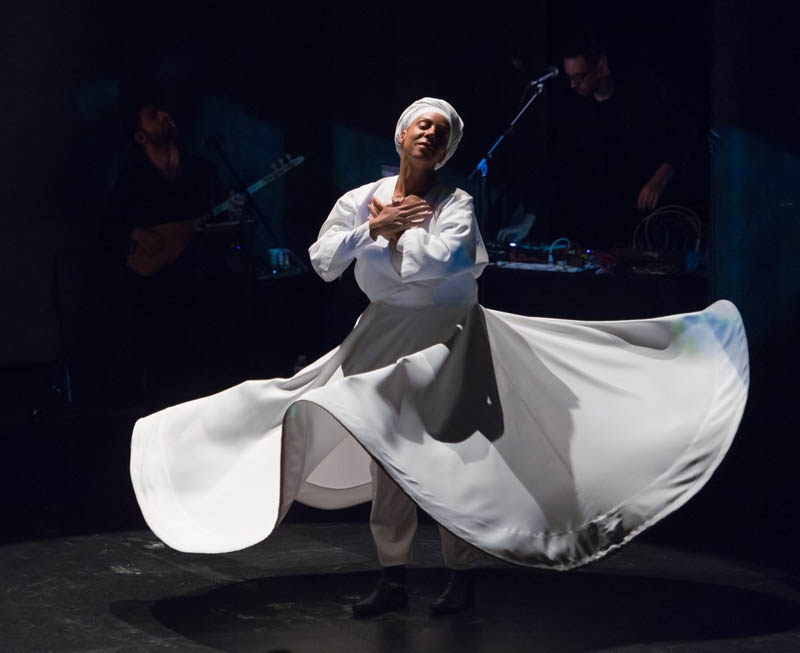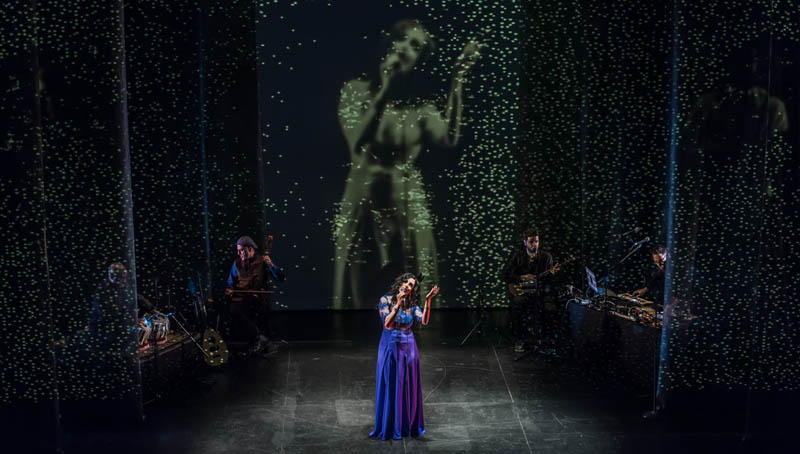|
In love, nothing exists between heart and heart.
Speech is born out of longing,
True description from the real taste.
The one who tastes, knows;
the one who explains, lies.
So wrote eighth-century mystic Rabia Al Basri, mother of Sufism and dedicatee of The Fourth Light. Such words practice what they preach, offering a twinkle of starlight that only hints at the spiritual fissions required to produce it. It’s an ethos of which a fortunate audience partook through the filter of Niyaz’s fractal soundscapes in their multimedia performance at New York City's Schimmel Center.
At the core of Niyaz are vocalist Azam Ali and multi-instrumentalist Loga Ramin Torkian on oud and kamaan (a custom viol-like instrument). They were joined by Sinan Cem Eroglu on kaval and komuz (Turkish flute and three-stringed lute), Gabriel Ethier on keyboards and programming, Ravi Naimpally on tabla, and whirling dervish Tanya Evanson, whom Ali credits as the genesis of this project. Live motion tracking was provided by Jérôme Delapierre, whose projections graced a series of vertical panels with ghostly echoes of the performers in real time.
To be sure, Ali was the focal point of the evening. Despite having heard her on record for nearly two decades since her days as one half of Vas, I became aware of terrains in her voice that only a live setting could map. It was a feeling akin to rebirth, as each syllable became a seed for new life. These supernatural overtones were only emphasized by Ali’s comportment on stage. Her dancing was a tribute to the music flowing through her, and her hand often moved in birdlike fashion, kissing sky and earth by way of the heart, as if to trace the paths of her creative impulses from and back to their source.
There was, too, an unmistakable vibration of growth in the air. Hers was a voice that could only have emanated from one who’d unlocked her maternity (as confirmed when she introduced her son at curtain call), if only because she made us listeners feel like her own children for that brief while in which we shared oxygen. That voice was cradle for an all-consuming love, and gave only the same return for the honor of being heard.
That said, over time she and her collaborators—much like the program itself—blended into a grander whole. It was impossible to think this was anything other than a desired effect, given the sentiments of open inclusion with which she left us in her post-concert comments. Her heartfelt message of art as an ecumenical realm of possibility, a space where rituals of historical redress serve as our only hope for recoverable futures, resonated as deeply as the music that preceded it.
There were, of course, highlights to be held like talismans of remembrance. Of those, the linguistic beauties of “Tam e Eshq” (The Taste of Love) continue to ring in my head like a gong of truth even as I write this, thus painting a line of interpretation to the verses with which I opened this review, as no level of description may never recreate the profile of love for those unknowing of its flavor: it must be held on the tongue to be known. Such sensory philosophies abounded in the groove of “Eyvallah Shahim” (Truth), as also in “Sabza Ba Naz” (The Triumph of Love). The latter’s call-and-response structure, made possible by prerecorded bits into which Ali threaded immediate counterparts, indicated a splitting of self as the first step toward restoring it.
Yet perhaps nowhere did the spirit of Rabia Al Basri come alive more than in Evanson’s dancing. In addition to the rare opportunity of witnessing dervishing in person, her direct line of communication from flesh to firmament served to visualize the music’s intentions in ways no computer-generated imagery ever could. She was a full embodiment of the concept of soul as animating force. When she appeared onstage dressed in black, only to reveal a crimson undercoat after shedding that layer of darkness, she expressed the inexhaustible need for life to write scripture in the very blood that flows through our collective veins. Last appearing in white, she further expressed an understanding that birth and death are two expressions of the same divine wish. (See video below)

As indicated by the title of The Fourth Light, its profound combination of melody, image, and dance depended on the governing power of sacred geometries. In the same way that a square’s enclosure couldn’t exist without a fourth side, neither could our minds express themselves without a fourth axis of light to give them shape in individual bodies. The resonances of this esotery were bright and uplifting. Like the silhouetted image of Ali holding up the sun that at one point froze on a rear screen, it gave us a void of outer space to fill with inner conclusions. In the end, I could only feel that we’d been left with a beginning, when first breaths defined every syllable around which we would eventually come to wrap our conscious decisions. More than ever, love has become the only emotion worth singing about, and I am grateful to Ali and her band of travelers that our paths crossed close enough to be reminded of its potency.
How can you describe the true form of Something
In whose presence you are blotted out?
And in whose being you still exist?
And who lives as a sign for your journey?
Watch a clip from a performance in Montreal last year.
|
